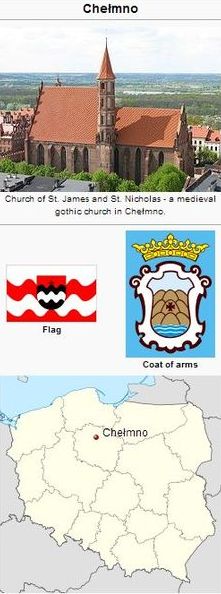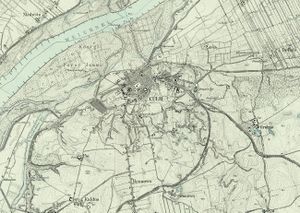Culm (Kuyavian-Pomeranian Voivodeship, Poland)
Culm (also known as Kulm, now Chełmno; coordinates: 53.34842° N, 18.42499° E [53° 20' 54.3" N, 18° 25' 30" E]; population in 1875, 9628, in 1910, 11,718, in 2006, 20,388), was located in former West Prussia, in the Marienwerder district, on the right bank of the Vistula, 24 miles (39 km) northwest of Thorn (Torun). Its population in 1910 included 276 Mennonites who belonged to the Schönsee congregation. They were partly of Dutch and partly of High German origin. Dutch Mennonites settled here as early as the middle of the 16th century; the High Germans probably came from Moravia during the first persecutions. These latter retained the old peasant coat with hooks and eyes until the first decades of the 19th century. On 22 August 1553 King Sigismund of Poland granted the Mennonites permission to settle here (F. Schultz, 12). About 1590 a union took place between the Frisians, who were for the most part immigrants from Holland, and the High Germans. In the lowlands of Culm and Schwetz there were two other congregations of the strict Groninger Old Flemish. Under the jurisdiction of the Culm bishops and several noblemen who valued the Mennonites as colonists all the groups enjoyed considerable liberty. On 17 June 1689 Bishop Casimir Opalinski gave them a charter of religious freedom and toleration. In 1728 the Bishop of Culm defended them against oppression by the clergy and gave them a written guarantee on this point. Because they had received several Lutherans and Catholics into their membership they were to be expelled from the district of the city of Culm by the episcopal edicts of 16 June and 9 July 1732. But by 6 April 1733, this edict was revoked, after they had been forced to pay 10,000 florins. They were assisted in raising this sum by their brethren in Holland. August III of Poland extended all the earlier privileges (granted by the kings John Casimir and John Sobieski) by a government rescript of 9 September 1750 (W. Mannhardt, 93-95), to the Mennonites of the Culm lowlands. In 1768 the Mennonites were expelled from several villages they had been living in since 1588, whereupon they settled to the northwest in Brenkenhofswalde in the province of Brandenburg. At the time of the first emigration to Russia (1789) the following Mennonites were living in the Culm region (Reisswitz, 321).
| Place | Men | Women | Sons | Daughters | Male Servants |
Female Servants |
| Schönsee | 13 | 11 | 22 | 18 | 2 | 6 |
| Dorposch | 3 | 10 | 20 | 12 | - | 1 |
| Grenz | 4 | 3 | 6 | 5 | - | - |
| Schwetzer Kampen | 10 | 9 | 15 | 17 | - | - |
| Nieder-Ausmass | 11 | 11 | 17 | 17 | 2 | 1 |
| Ober-Ausmass | 2 | 2 | 6 | 5 | - | - |
| Klein-Lunau | 20 | 21 | 20 | 21 | 1 | - |
| Gross-Lunau | 14 | 12 | 13 | 15 | 8 | 2 |
| Jamerau | 10 | 10 | 12 | 9 | 4 | - |
| Schöneck (Schöneich) | 12 | 12 | 9 | 19 | 3 | 2 |
| Rossgarten | 1 | 2 | 4 | 2 | - | - |
| Steinwage | 2 | 2 | 6 | 1 | 2 | - |
| Gogolin | 4 | 4 | 6 | 8 | 3 | 2 |
| Horst | 3 | 3 | 12 | 5 | - | 2 |
| Subtotals | 109 | 112 | 168 | 154 | 25 | 16 |
| Totals | 584 |
In the following years the number of Mennonites decreased steadily. Census statistics show: 1861, 580; 1871, 505; 1880, 407; 1890, 385; 1900, 342; and 1910, 276. In 1945-48 the German-speaking population of this area, including the Mennonite settlement, was completely wiped out either by flight or by deportation by the Polish government, as a result of the victory of Russia over the German armies.
Bibliography
Brons, A. Ursprung, entwickelung und shicksale der altevangelischen taufgesinnten oder Mennoniten in kurzen Zugen übersichtlich dargestellt. Emden, 1912.
"Chełmno." Wikipedia. Web. 30 September 2012. http://en.wikipedia.org/wiki/Chełmno.
"Familienforschung in Westpreußen." Hans-Jürgen Wolf. Web. 29 September 2012. http://www.westpreussen.de/pages/forschungshilfen/ortsverzeichnis/details.php?ID=3726.
Hege, Christian and Christian Neff. Mennonitisches Lexikon, 4 vols. Frankfurt & Weierhof: Hege; Karlsruhe: Schneider, 1913-1967: v. I, 382 f.
Hoop Scheffer, Jacob Gijsbert de. Inventaris der Archiefstukken berustende bij de Vereenigde Doopsgezinde Gemeente to Amsterdam, 2 vols. Amsterdam: Uitgegeven en ten geschenke aangeboden door den Kerkeraad dier Gemeente, 1883-1884: v. I, Nos. 1091, 1367, 1574, 1647, 1648, 1702; v. II, 2, No. 779.
Mannhardt, W. Die Wehrfreiheit der Altpreussischen Mennoniten. Danzig, 1863.
Reisswitz, Georg Leopold and Friedrich Wadzeck, Beiträge zur Kenntnis der Mennoniten-Gemeinden in Europa und America, statistischen, historischen und religiösen Inhalts. Berlin, 1821.
Schultz, Franz. Geschichte der Stadt Kulm in skizzierter Darstellung. Kulm: Brandt, 1872.
Starck, J. A. Geschichte der Taufe und Taufgesinnten. Leipzig, 1789.
Wiebe, H. Das Siedlungswerk niederländischer Mennoniten im Weichseltal zwischen Fordon und Weissenberg bis zum Ausgang des 18. Jahrhunderts. Marburg, 1952.
Maps
Map:Chełmno (Kuyavian-Pomeranian Voivodeship, Poland)
| Author(s) | Christian Neff |
|---|---|
| Date Published | 1953 |
Cite This Article
MLA style
Neff, Christian. "Culm (Kuyavian-Pomeranian Voivodeship, Poland)." Global Anabaptist Mennonite Encyclopedia Online. 1953. Web. 16 Apr 2024. https://gameo.org/index.php?title=Culm_(Kuyavian-Pomeranian_Voivodeship,_Poland)&oldid=174052.
APA style
Neff, Christian. (1953). Culm (Kuyavian-Pomeranian Voivodeship, Poland). Global Anabaptist Mennonite Encyclopedia Online. Retrieved 16 April 2024, from https://gameo.org/index.php?title=Culm_(Kuyavian-Pomeranian_Voivodeship,_Poland)&oldid=174052.
Adapted by permission of Herald Press, Harrisonburg, Virginia, from Mennonite Encyclopedia, Vol. 1, pp. 745-746. All rights reserved.
©1996-2024 by the Global Anabaptist Mennonite Encyclopedia Online. All rights reserved.


